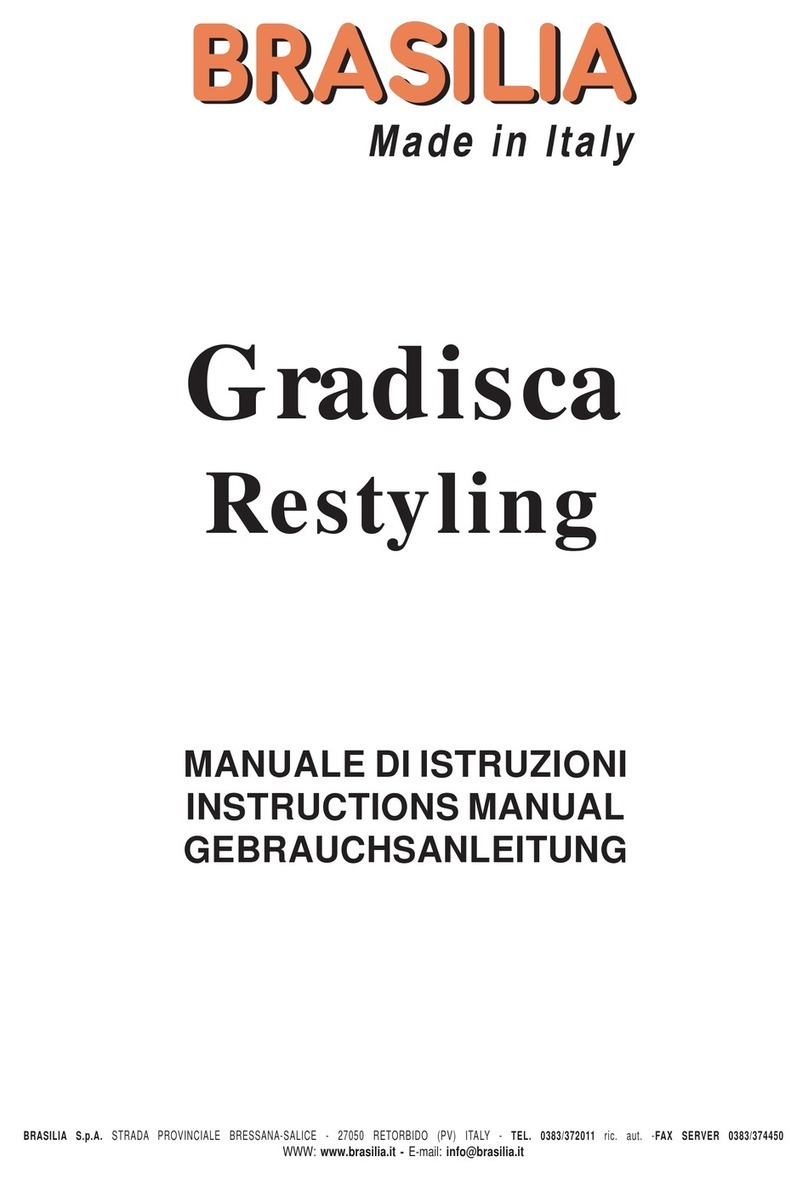Club 7
rev.8 - 08/2004
Una volta riempito il portafiltro, pressate il caffè macinato con l’apposito pressino, spingendo all’insù il portafiltro. Pulite con il palmo della mano il
bordo del portafiltro per eliminare l’eccesso di polvere di caffè. In questo modo sarete certi che la tenuta fra il portafiltro e la macchina sarà
perfetta.
Nel caso in cui si dispone di un filtro ad uso misto, è possibile inserirVi una cialda di caffè anzichè il caffè macinato. Nel caso invece in cui si
dispone di un modello a cialda, inserire una cialda di caffè nel filtro.
Agganciate il portafiltro nel gruppo della macchina, ruotando fino a che sia fissato. Non stringete troppo, altrimenti sarà difficile da togliere dopo
l’erogazione.Dopo aver agganciato correttamente il portafiltro, ponete una tazza, precedentemente scaldata, sotto il beccuccio. Nel caso di
portafiltro doppio, usate due tazze.
Azionate il gruppo premendo il pulsante erogazione caffé (part.2 fig.1).
Non appena raggiunta la quantità di caffè desiderata, ripremere l’interruttore. L’erogazione è terminata, togliete la tazza e servite.
Erogazione acqua calda e vapore
Per erogare acqua calda dal relativo beccuccio (part.12 fig.1), aprire il rubinetto (part.11). Lasciare aperto il rubinetto (part.11) e premere il
pulsante erogazione acqua calda (part.3). Dopo aver ottenuto la quantità d’acqua desiderata, rilasciare il pulsante e chiudere il rubinetto.
Per erogare vapore, aprire il rubinetto (part. 11 ) e lasciarlo aperto fino all’inizio dell’erogazione di vapore (inizialmente uscirà acqua calda ).
Chiudere il rubinetto, premere il pulsante vapore (part. 4) per 15 secondi in modo da aumentare la temperatura in caldaia. Immergere il beccuccio
nel liquido da scaldare o da emulsionare. Aprire il rubinetto di nuovo e, mantenendo premuto il pulsante (part. 4) prelevare la quantità di vapore
desiderata.(La disponibilità di vapore è sufficiente per la preparazione di 2 cappuccini).
Se la macchina è dotata di dispositivo “Turbosteam”, la quantità di vapore disponibile è superiore.
Terminata la richiesta di vapore, chiudete il rubinetto (part.11) e premete il pulsante (part.3). In tal modo viene ricaricata la caldaia, sino all’arresto
del funzionamento della pompa.
Come fare il cappuccino
Per fare un cappuccino occorre montare del latte fresco fino ad ottenere una schiuma che verrà
versata sopra l’espresso.
Per emulsionare il latte occorre aprire il rubinetto (part. 11) e lasciarlo aperto fino a quando inizia ad
erogare vapore ( inizialmente uscirà acqua calda). Chiudere il rubinetto e premere il pulsante vapore
(part. 4) per 15 secondi in modo da aumentare la temperatura in caldaia.
Usate un bricco per scaldare, contenente almeno tre pollici di latte. Immergere la lancia del vapore nel
bricco contenente il latte da emulsionare. Aprire nuovamente il rubinetto e tenere il bricco inclinato
con la lancia posizionata come nella figura (non al centro e non a contatto con le pareti del bricco).
Durante il riscaldamento del latte controllare che il beccuccio diffusore di vapore sia sempre immerso
nel latte fino al raggiungimento della giusta temperatura e del grado di emulsione desiderata. Quindi
richiudere il rubinetto , togliere il bricco dalla lancia e versare il latte emulsionato sul caffè .( La dispo-
nibilità di vapore è sufficiente per la preparazione di due cappuccini). Detergere infine la lancia con
un panno umido in modo da rrimuovere tutti i residui di latte per evitare che questo, seccando, diventi
difficile da rimuovere.
Attenzione: la lancia vapore è molto calda e non bisogna toccarla fin quando non si sarà
raffreddata.
Informate il cliente appena possibile del fatto che la bevanda è molto calda. Tenete da parte il latte
montato per il prossimo cappuccino.
MANUTENZIONE
Operazioni di pulizia giornaliera
Da effettuare preferibilmente la sera:
- Pulire doccetta, guarnizione sottocoppa e guide portafiltro dei gruppi erogatori con un pannospugna.
- Sciacquare filtri e portafiltri in acqua calda con l’aggiunta di detergente specifico, per sciogliere i depositi grassi del caffè.
- Lavare la vaschetta di scarico e la griglia poggiatazze (part.8 fig.1) con dell’acqua.
- Pulire accuratamente la lancia del vapore usata per riscaldare bevande subito dopo l’uso, onde evitare il formarsi di incrostazioni che possono
otturare i fori del diffusore ed evitare inoltre che bevande di diversa natura riscaldate in precedenza possano alterare il sapore delle bevande in
riscaldamento.
Operazioni di pulizia settimanali
- Pulizia serbatoio: riempire il serbatoio (part.10 fig.1) con dell’acqua e versarvi 3 o 4 cucchiaini di acido citrico o di aceto; lasciare questa miscela
nel serbatoio finchè esso sarà ben pulito. Svuotare poi il serbatoio facendo uscire parte dell’acqua dalla coppa porta-filtro (part.6) e parte dal
beccuccio acqua calda-vapore (part.12). Ripetere l’operazione di lavaggio, rimpendo il serbatoio di sola acqua.
Attenzione: è opportuno cambiare spesso l’acqua della caldaia nelle macchine con caldaia di piccola capacità.
- Pulizia carrozzeria: usare un panno umido (non abrasivo). Non usare assolutamente alcool o solventi sulle parti scritte o verniciate.







































